Presidential Amendments

††††† Unit Overview
In this
unit, students will identify and explain the historical circumstances
surrounding the adoption of amendments about presidential elections, terms, and
succession. (CS#11)
††††††††††††† Section A:† Content Statement 11
Constitutional
amendments have altered provisions for the structure and functions of the federal government.
Content
Elaboration
The Framers
of the Constitution created a method
of presidential
selection that reflected the nation's federal system of government. The
President would be chosen based on electoral
votes from the states. A candidate is required to win a majority of the total number of electoral
votes to secure the Presidency. Electoral votes are determined based upon the
number of each state's representatives
and senators.
Some
amendments have altered the procedures of the Electoral College:
†††††† ē Separate balloting for President and Vice
President was established to avoid a tie in electoral votes.
†††††† ē The District of Columbia was granted
electoral votes.
Other
amendments have altered the functioning of government:
†††††† ē Presidential term limits.
†††††† ē Presidential succession and disability.
Letís Practice: Content Statement 11
††††††††† Section B:† Presidential Amendments
Letís Practice:† Electoral College
Constitutional
provisions related to the executive branch of the federal
government have been frequent subjects for amendment. The amendments have
responded to events impacting presidential elections, terms and succession.
Amendment 12 altered the procedures
of the Electoral College. The change allowed separate balloting for President
and Vice President to avoid a tie in electoral votes, as happened in the
election of 1800.
The main
provisions of Amendment 20 shortened
the time between elections and when presidents and members of Congress take
office. These changes reflected the improvements in transportation, which
allowed for more comfortable travel to Washington and also revealed the desire
to avoid "lame duck" periods in the transition from one administration
or session to another.
Amendment 22 imposed a two-term
limit on presidential terms. This amendment was passed following the four-term Presidency
of Franklin Roosevelt to institutionalize the two-term tradition established by
George Washington.
Amendment 23 provided electors for
the District of Columbia. The Electoral College was based initially upon
electors representing states. As the population of the District of Columbia grew,
it was decided that the residents there deserved to have the opportunity to
vote for electors in presidential elections.
Presidential succession and disability were addressed by Amendment 25. Lyndon B. Johnson, who
had a history of heart problems, took office following the assassination of
John F. Kennedy. As with other presidential successions, this left the office
of the vice president vacant. The 25th Amendment clarified that a successor to
the Presidency was designated as President of the United States and included
provisions for filling the office of Vice President. It also outlined
procedures to be used in case of presidential disability.
Letís Practice: True or False
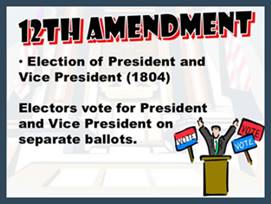 †
†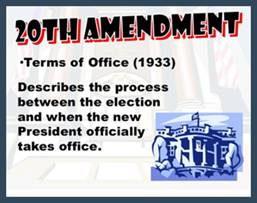 †
†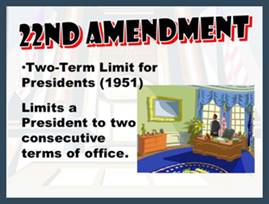 †
†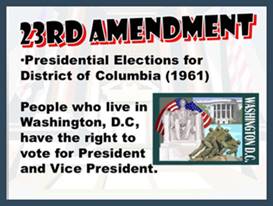 †
†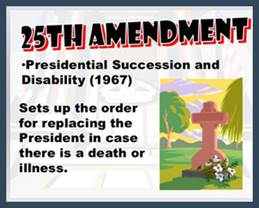
Five
amendments have altered provisions for presidential elections, terms, and
successions to address changing historical circumstances.
Below is a
chart on the historical roots of the Presidential Amendments.
|
Amendment |
Rights |
Historic Roots |
|
12th
Election
of President and
Vice
President |
∑ Electors to the Electoral College are to cast one vote for
President and a separate vote for Vice President |
In the election of 1800, confusion in the Electoral College
resulted from the requirement that the runner-up for President became President. |
|
20th
† Presidential
Inauguration |
∑ President and Vice President are sworn into office on January
20th |
The amendment shortens the "lame duck" time by
moving inauguration up by two months. |
|
22nd
† Presidential
Term Limits |
∑ No person may serve as President more than twice |
George Washington had sent the precedent of two terms.† All other presidents continued to serve no
more than two terms; unit Franklin D. Roosevelt was elected a record four
times.† After his administration ended,
there was widespread support for a formal limit on presidential terms. |
|
23rd
Voting
in Washington, D.C. |
∑ Grants Washington D.C. three electoral votes for the
Presidency |
Residents of Washington D.C. did not have any political voice
in the federal government.† This
amendment grants them the minimum number of electors. |
|
25th Presidential
Succession |
∑ Establishes a clearer succession to the Presidency and Vice Presidency |
During the era of the Cold War and in the wake of John F.
Kennedy's assassination, a transparent chain of ascension to the nation's
highest office was needed |
Letís Practice: Image Amendments